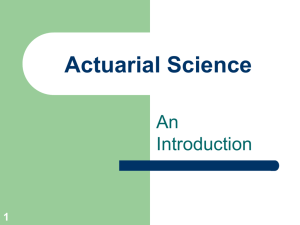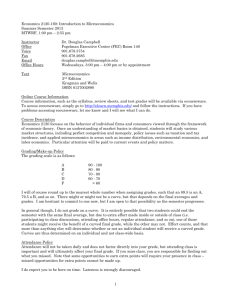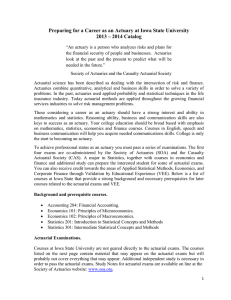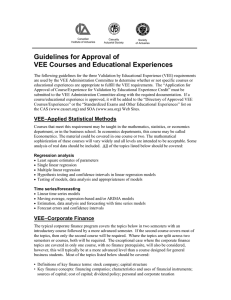Actuarial Science An Introduction What is an Actuary?
advertisement
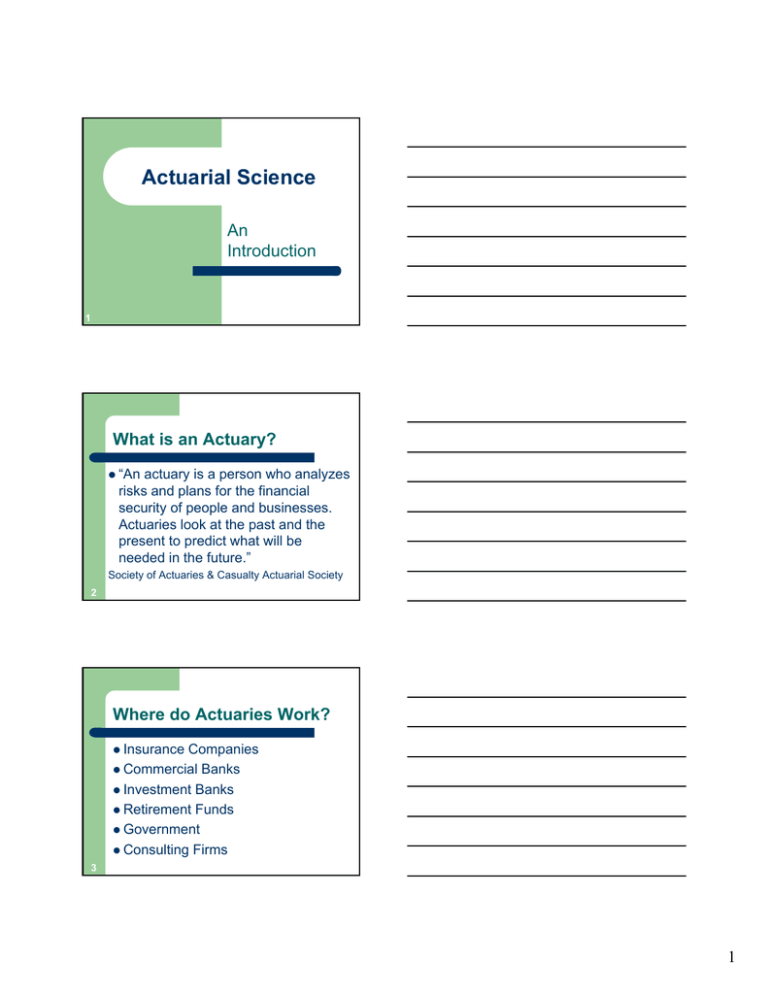
Actuarial Science An Introduction 1 What is an Actuary? “An actuary is a person who analyzes risks and plans for the financial security of people and businesses. Actuaries look at the past and the present to predict what will be needed in the future.” Society of Actuaries & Casualty Actuarial Society 2 Where do Actuaries Work? Insurance Companies Commercial Banks Investment Banks Retirement Funds Government Consulting Firms 3 1 How to become an Actuary? Majors Statistics/Math Finance – Economics – – Complete 4 Validation by Educational Experience (VEE) Pass Actuarial Exams VEE – Applied Statistical Methods Statistics 301 – Intermediate Statistical Concepts and Methods Statistics 451 – Applied Time Series Grade of B- or higher in both courses 5 VEE – Corporate Finance Finance 310 – Corporate Finance 6 2 VEE - Economics Although you can complete this VEE by taking Econ 101/102 we strongly recommend: Economics 301 – Intermediate Microeconomics – Economics 302 – Intermediate Macroeconomics – 7 Course Work in Statistics and Mathematics Math 165, 166, 265: Calculus I, II, and III Statistics 201 Statistics 341 Statistics 342 Statistics 301 Statistics 451 8 Course Work in Economics Economics 101: Principles of Microeconomics Economics 102: Principles of Macroeconomics Economics 301: Intermediate Microeconomics Economics 302: Intermediate Macroeconomics 9 3 Course Work in Finance and Accounting Accounting 284: Financial Accounting Finance 301: Principles of Finance Finance 310: Corporate Finance Finance 361: Personal Risk Management and Insurance Finance 462: Corporate Risk Management and Insurance 10 Actuarial Exams Every Fall and Spring 1: Probability (P) 2: Financial Mathematics (FM) – 3: Models for Financial Economics (MFE) Models for Life Contingencies (MLC) – 4: Construction and Evaluation of Actuarial Models (C) – – 11 Exam 1/P Probability (P) http://www.soa.org/education/examreq/edu-exam-p-detail.aspx Take AFTER you have completed Stat 341. 12 4 Exam 2/FM Financial 13 Mathematics (FM) http://www.soa.org/education/examreq/edu-exam-fm-detail.aspx There is no course at ISU that prepares you for this exam. You can take this exam before Exam 1/P Exam 3/M Actuarial Models (M) – Financial Economics (MFE) http://www.soa.org/education/exam-req/eduexam-mfe-detail.aspx – Life Contingencies (MLC) http://www.soa.org/education/exam-req/eduexam-m-detail.aspx There is no course at ISU that prepares you for this exam. 14 Exam 4/C Construction and Evaluation of Actuarial Models http://www.soa.org/education/examreq/edu-exam-c-detail.aspx There is no course at ISU that prepares you for this exam. 15 5 Things to consider Start course work early Minor in Economics Double-Major in Finance?? Summer Internship after junior year Pass rate on Exams – Between 35% - 40% Studying for exams is time consuming! 16 How much?? Casualty – Oct. 2012 www.dwsimpson.com/salary.html Starting Salary (pass 1 exam) – Middle 80% $46,000 to $66,000 After 5 years (pass 4 exams) – Middle 80% 73,000 to 100,000 After 10 years (Associate) After 15 years (Fellow) – – Middle 80% 118,000 to 193,000 Middle 80% 175,000 to 450,000+ 17 How much?? Life & Health – Oct. 2012 www.dwsimpson.com/salary.html Starting Salary (pass 1 exam) After 5 years (pass 4 exams) After 10 years (Associate) – – – Middle 80% $50,000 to $58,000 Middle 80% 72,000 to 101,000 Middle 80% 96,000 to 160,000 After 15 years (Fellow) – Middle 80% 148,000 to 329,000 18 6 Information on Web Society of Actuaries – www.soa.org Casualty Actuarial Society – www.casact.org Be An Actuary – www.beanactuary.org – – – Exams Video FAQ 19 7
